An Experimental Study on the Performance of Corrugated Cardboard as a Sustainable Sound-Absorbing and Insulating Material
Abstract
1. Introduction
2. Materials and Methods
2.1. Sample Preparation
2.2. Measurement of Sound-Absorption Coefficient Using Transfer Function Method
2.3. STL Measurements Using Transmission Matrix Method
2.4. Sound Pressure Level Analysis
3. Results and Discussion
3.1. SAC Results from Transfer Function Method
3.2. STL Results from Transmission Matrix Method
3.3. Sound Pressure Level Analysis
4. Conclusions
- Corrugated cardboard itself had a sound insulation effect.
- The NRC of PCC and PCCM were 0.346 (SD 0.007) and 0.423 (0.009), respectively. The average sound pressure level of the blender using NPCC, PCC, and PCCM were 75.500 (SD 0.432) dB, 72.133 (SD 1.096) dB, and 64.367 (SD 0.573) dB, respectively.
- Compared with other NRC natural fiber composite board, Wooden MPP, and NPCC (parallel direction), and the PCCM demonstrated higher sound-absorption capabilities
- PCCM shows considerable promise as a sustainable, eco-friendly sound-absorbing and insulating material.
Author Contributions
Funding
Institutional Review Board Statement
Informed Consent Statement
Data Availability Statement
Conflicts of Interest
References
- Kim, E.-S. Sound and the Korean public: Sonic citizenship in the governance of apartment floor noise conflicts. Sci. Cult. 2016, 25, 538–559. [Google Scholar] [CrossRef]
- Szopińska, K.; Krajewska, M. Prices of apartments in relation to noise level in Poland. J. Civ. Eng. Archit. 2013, 7, 1189–1195. [Google Scholar] [CrossRef]
- NOISEINFO. Field Diagnosis and Measurement Service of Noise. Available online: http://www.noiseinfo.or.kr/about/stats/fieldDiagnosisSttus_02.jsp (accessed on 6 December 2020).
- Moebus, S.; Gruehn, D.; Poppen, J.; Sutcliffe, R.; Haselhoff, T.; Lawrence, B. Acoustic quality and urban health-more than just noise and silence. Bundesgesundh. Gesundh. Gesundh. 2020, 63, 997–1003. [Google Scholar] [CrossRef]
- Hassan, T.; Jamshaid, H.; Mishra, R.; Khan, M.Q.; Petru, M.; Novak, J.; Choteborsky, R.; Hromasova, M. Acoustic, Mechanical and Thermal Properties of Green Composites Reinforced with Natural Fibers Waste. Polymers 2020, 12, 654. [Google Scholar] [CrossRef] [PubMed]
- Atienzar-Navarro, R.; Del Rey, R.; Jesus, A.; Sanchez-Morcillo, V.J.; Pico, R. Sound Absorption Properties of Perforated Recycled Polyurethane Foams Reinforced with Woven Fabric. Polymers 2020, 12, 401. [Google Scholar] [CrossRef]
- Leiva, C.; Arenas, C.; Vilches, L.F.; Alonso-Farinas, B.; Rodriguez-Galan, M. Development of fly ash boards with thermal, acoustic and fire insulation properties. Waste Manag. 2015, 46, 298–303. [Google Scholar] [CrossRef]
- Feng, L. Enhancement of low frequency sound absorption by placing thin plates on surface or between layers of porous materials. J. Acoust. Soc. Am. 2019, 146, EL141. [Google Scholar] [CrossRef]
- Gardonio, P.; Zilletti, M. Integrated tuned vibration absorbers: A theoretical study. J. Acoust. Soc. Am. 2013, 134, 3631–3644. [Google Scholar] [CrossRef]
- Long, H.; Cheng, Y.; Liu, X. Reconfigurable sound anomalous absorptions in transparent waveguide with modularized multi-order Helmholtz resonator. Sci. Rep. 2018, 8, 15678. [Google Scholar] [CrossRef]
- Kim, S.; Kim, Y.H.; Jang, J.H. A theoretical model to predict the low-frequency sound absorption of a helmholtz resonator array. J. Acoust. Soc. Am. 2006, 119, 1933–1936. [Google Scholar] [CrossRef] [PubMed]
- Iannace, G.; Trematerra, A. Acoustic measurements and correction of a council room. Noise Vib. Worldw. 2014, 45, 12–16. [Google Scholar] [CrossRef]
- Iannace, G.; Ciaburro, G. Modelling sound absorption properties for recycled polyethylene terephthalate-based material using Gaussian regression. Build. Acoust. 2020. [Google Scholar] [CrossRef]
- Asdrubali, F.; Schiavoni, S.; Horoshenkov, K. A review of sustainable materials for acoustic applications. Build. Acoust. 2012, 19, 283–311. [Google Scholar] [CrossRef]
- Iannace, G.; Bravo-Moncayo, L.; Ciaburro, G.; Puyana-Romero, V.; Trematerra, A. The use of green materials for the acoustic correction of rooms. In Proceedings of the INTER-NOISE and NOISE-CON Congress and Conference Proceedings, Madrid, Spain, 30 September 2019; pp. 2589–2597. [Google Scholar]
- Yang, H.S.; Kim, D.J.; Kim, H.J. Rice straw-wood particle composite for sound absorbing wooden construction materials. Bioresour. Technol. 2003, 86, 117–121. [Google Scholar] [CrossRef]
- António, J.; Tadeu, A.; Marques, B.; Almeida, J.A.; Pinto, V. Application of rice husk in the development of new composite boards. Constr. Build. Mater. 2018, 176, 432–439. [Google Scholar] [CrossRef]
- Chen, C.; Wang, Z.; Zhang, Y.; Bi, M.; Nie, K.; Wang, G. Investigation of the hydrophobic and acoustic properties of bio windmill palm materials. Sci. Rep. 2018, 8, 13419. [Google Scholar] [CrossRef] [PubMed]
- Iannace, G.; Trematerra, A.; Trematerra, P. Acoustic correction using green material in classrooms located in historical buildings. Acoust. Aust. 2013, 41, 213–218. [Google Scholar]
- Iannace, G.; Berardi, U.; Ciaburro, G.; Trematerra, A. Egg cartons used as sound absorbing systems. In Proceedings of the INTER-NOISE and NOISE-CON Congress and Conference Proceedings, Seoul, Korea, 12 October 2020; pp. 405–412. [Google Scholar]
- Jang, E.-S.; Kang, C.-W.; Kang, H.-Y.; Jang, S.-S. Sound Absorption Property of Traditional Korean Natural Wallpaper (Hanji). J. Korean Wood Sci. Technol. 2018, 46, 703–712. [Google Scholar] [CrossRef]
- Lin, L.; Yang, J.; Ni, S.; Wang, X.; Bian, H.; Dai, H. Resource utilization and ionization modification of waste starch from the recycling process of old corrugated cardboard paper. J. Environ. Manag. 2020, 271, 111031. [Google Scholar] [CrossRef]
- Asdrubali, F.; Pisello, A.; D’Alessandro, F.; Bianchi, F.; Cornicchia, M.; Fabiani, C. Innovative cardboard based panels with recycled materials from the packaging industry: Thermal and acoustic performance analysis. Energy Procedia 2015, 78, 321–326. [Google Scholar] [CrossRef]
- Langfeldt, F.; Hoppen, H.; Gleine, W. Resonance frequencies and sound absorption of Helmholtz resonators with multiple necks. Appl. Acoust. 2019, 145, 314–319. [Google Scholar] [CrossRef]
- Diarte, J.; Vazquez, E.; Shaffer, M. Tooling Cardboard for Smart Reuse: A Digital and Analog Workflow for Upcycling Waste Corrugated Cardboard as a Building Material. In Proceedings of the International Conference on Computer-Aided Architectural Design Futures, Daejeon, Korea, 26–28 June 2019; pp. 384–398. [Google Scholar]
- Schonwalder, J.; Rots, J.G. Cardboard: An innovative construction material. In Sustainable Construction Materials and Technologies; Chun, Y., Claisse, P., Naik, T.R., Ganjian, E., Eds.; Taylor & Francis: Leiden, The Netherlands, 2007; pp. 731–740. [Google Scholar]
- Xia, X.; Dong, Z.; Zhag, X. Study on a New Type of Hydrophobic and Moisture Proof Packaging Board and Its Performance. Packag. Eng. 2010, 31, 13–16. [Google Scholar]
- Cataldi, P.; Profaizer, M.; Bayer, I.S. Preventing water-induced mechanical deterioration of cardboard by a sequential polymer treatment. Ind. Eng. Chem. Res. 2019, 58, 6456–6465. [Google Scholar] [CrossRef]
- Yang, G.; Liu, J.; Xu, B.; Liu, Z.; Ma, F.; Zhang, Q. Effect of silicon-containing nitrogen and phosphorus flame-retardant system on the mechanical properties and thermal and flame-retardant behaviors of corrugated cardboard. J. Anal. Calorim. 2020. [Google Scholar] [CrossRef]
- Berardi, U.; Iannace, G. Acoustic characterization of natural fibers for sound absorption applications. Build. Environ. 2015, 94, 840–852. [Google Scholar] [CrossRef]
- Kang, C.; Seo, Y. Sound absorption and sound transmission loss of perforated corrugated board. J. Korea TAPPI 2018, 50, 32–39. [Google Scholar] [CrossRef]
- Kang, C.-W.; Kim, M.K.; JANG, E.S.; Lee, Y.-H.; Jang, S.-S. Sound Absorption Coefficient and Sound Transmission Loss of Porous Sponge Attached Corrugated Cardboard of Noise Insulation Cover. J. Korea TAPPI 2020, 52, 38–44. [Google Scholar] [CrossRef]
- Epp, S.; Konz, S. Home appliance noise: Annoyance and speech interference. Home Econ. Res. J. 1975, 3, 205–209. [Google Scholar] [CrossRef]
- ISO11534-2. Acoustics-Determination of Sound Absorption Coefficient and Impedance in Impedance Tubes-Part 2 Transfer-Function Method; International Organization for Standardization (ISO): Geneva, Switzerland, 2001. [Google Scholar]
- ASTM E2611-19. Standard Test Method for Normal Incidence Determination of Porous Material Acoustical Properties Based on the Transfer Matrix Method; ASTM International: West Conshohocken, PA, USA, 2019. [Google Scholar]
- Sharma, S.; Shukla, S.; Sethy, A. Acoustical behaviour of natural fibres-based composite boards as sound-absorbing materials. J. Indian Acad. Wood Sci. 2020, 17, 66–72. [Google Scholar] [CrossRef]
- Song, B.; Peng, L.; Fu, F.; Liu, M.; Zhang, H. Experimental and theoretical analysis of sound absorption properties of finely perforated wooden panels. Materials 2016, 9, 942. [Google Scholar] [CrossRef]
- Mitchell, M.; Muftakhidinov, B.; Winchen, T.; Jedrzejewski-Szmek, Z. Engauge Digitizer Software. Available online: https://markummitchell.github.io/engauge-digitizer/ (accessed on 8 April 2021).
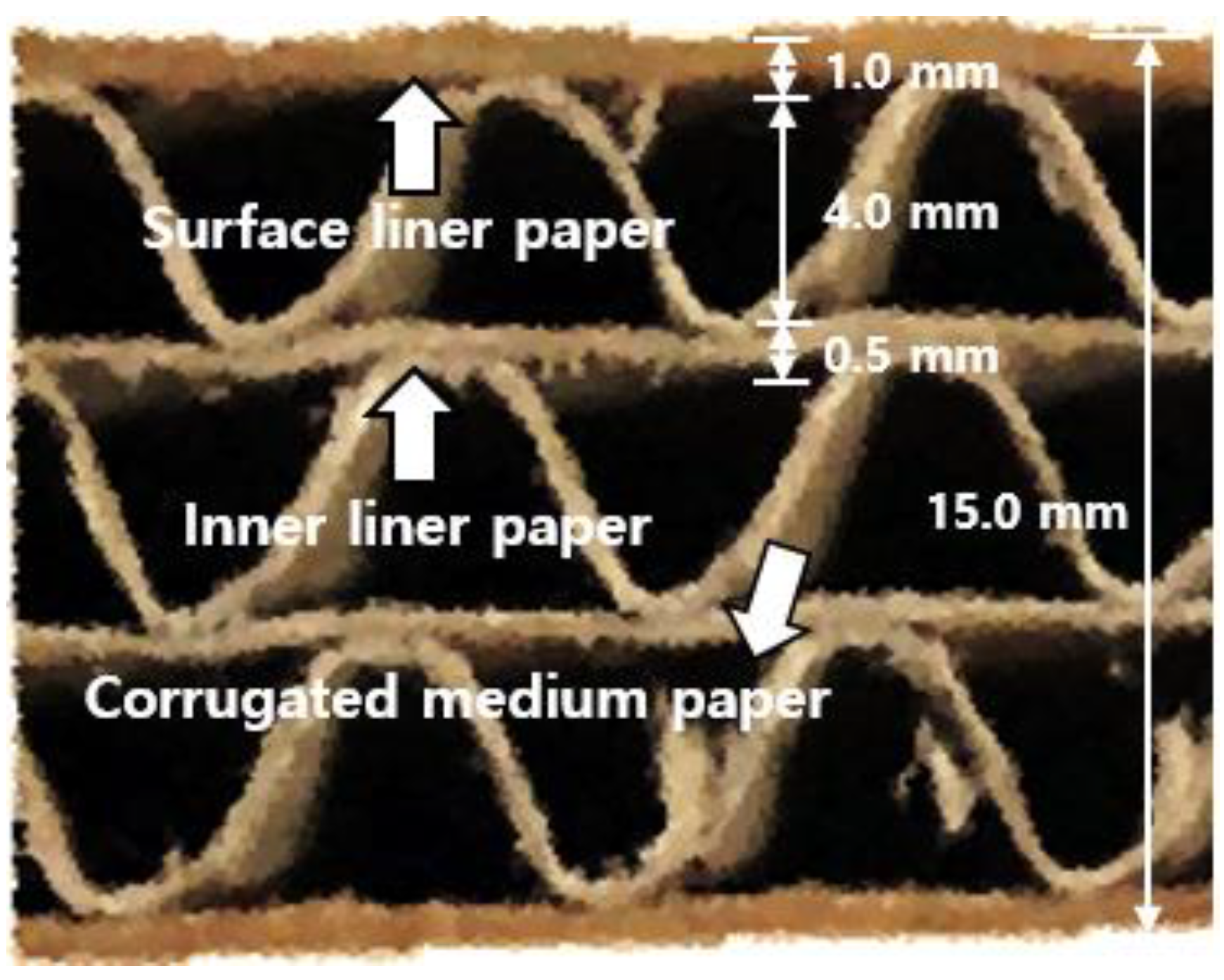
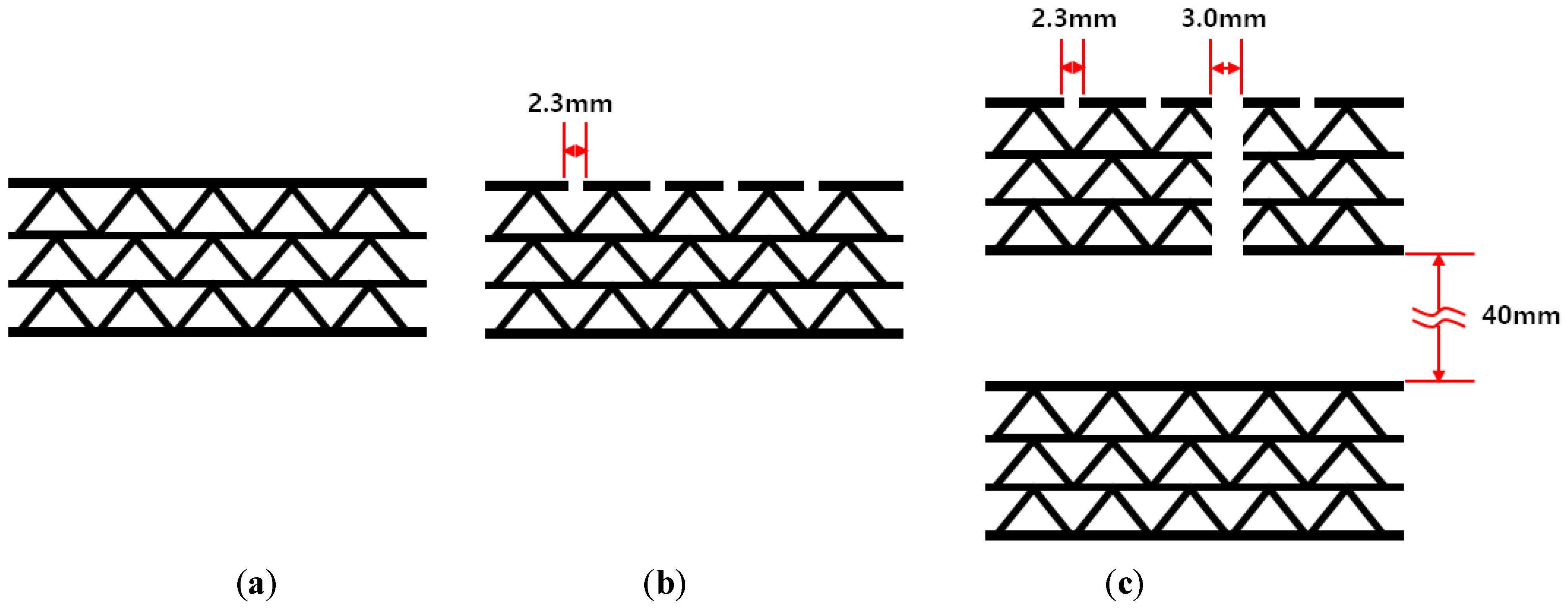
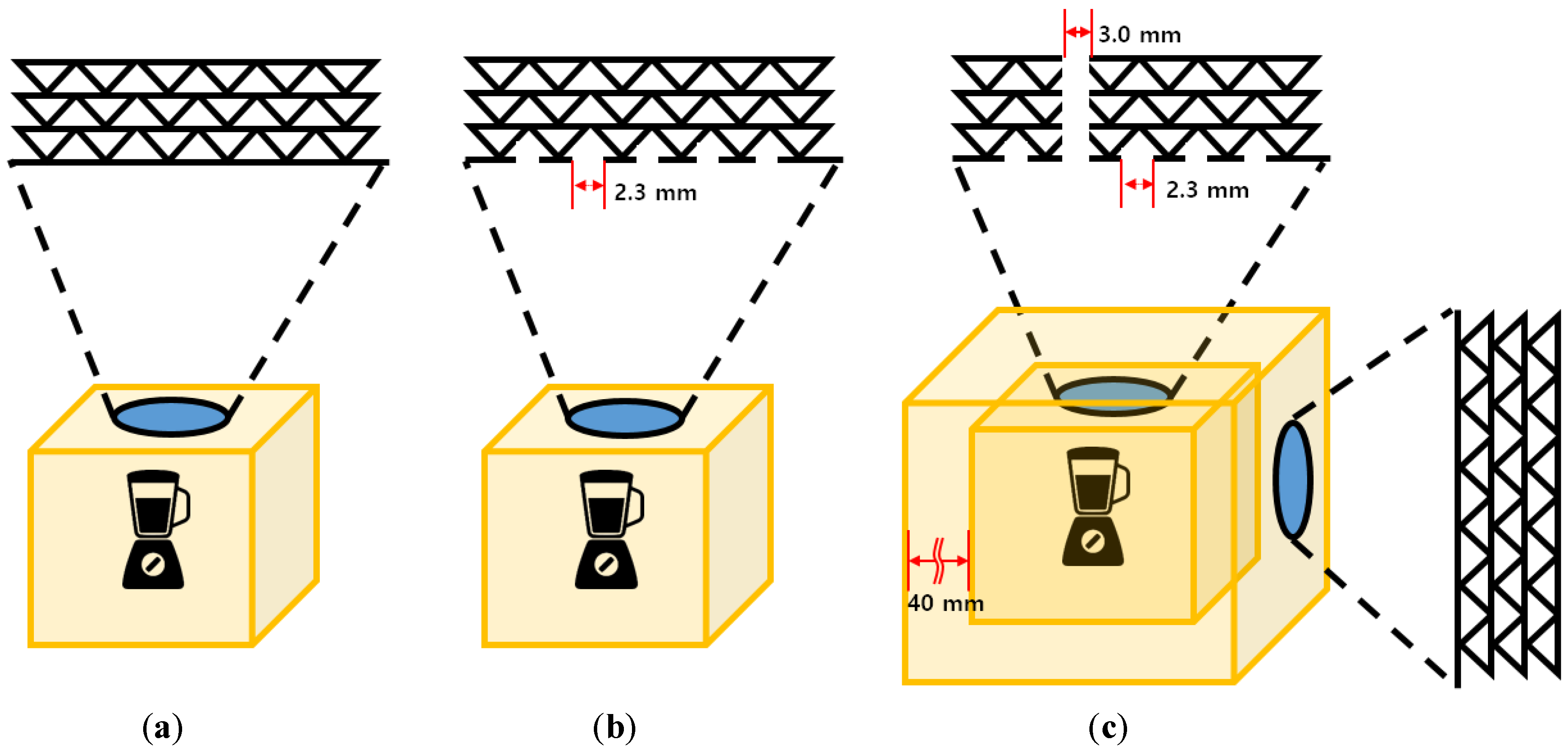


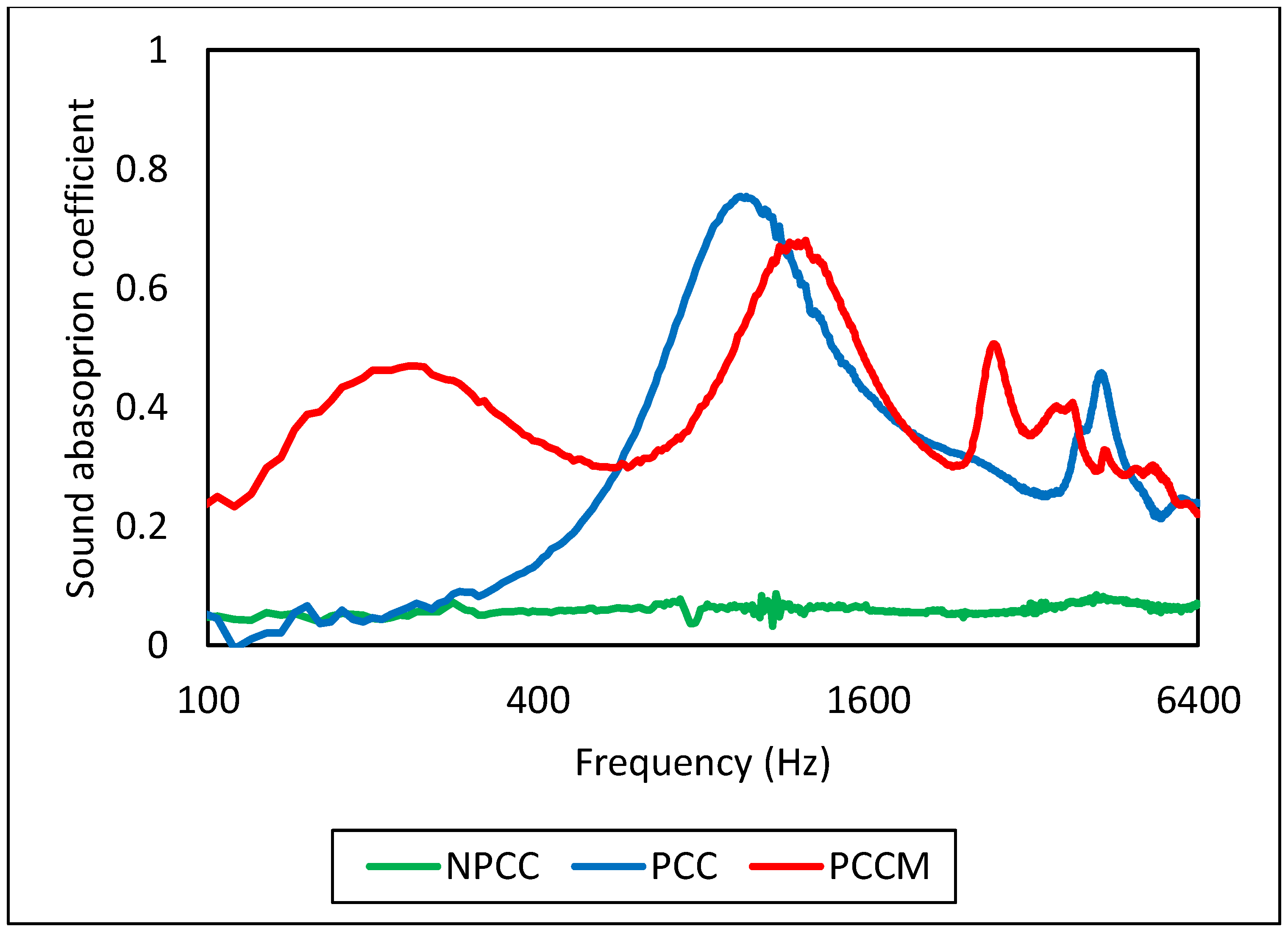


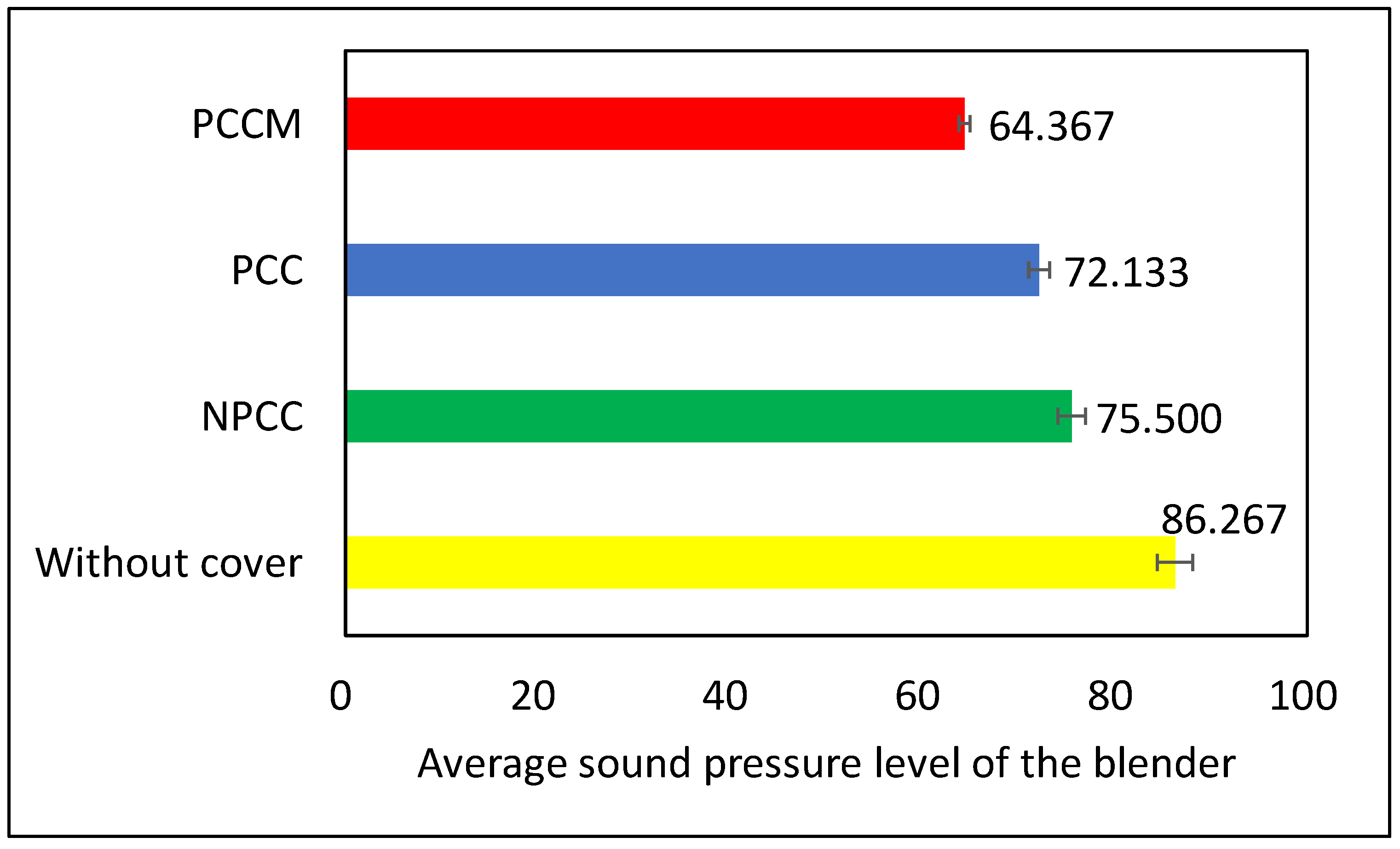
Publisher’s Note: MDPI stays neutral with regard to jurisdictional claims in published maps and institutional affiliations. |
© 2021 by the authors. Licensee MDPI, Basel, Switzerland. This article is an open access article distributed under the terms and conditions of the Creative Commons Attribution (CC BY) license (https://creativecommons.org/licenses/by/4.0/).
Share and Cite
Kang, C.-W.; Kim, M.K.; Jang, E.-S. An Experimental Study on the Performance of Corrugated Cardboard as a Sustainable Sound-Absorbing and Insulating Material. Sustainability 2021, 13, 5546. https://doi.org/10.3390/su13105546
Kang C-W, Kim MK, Jang E-S. An Experimental Study on the Performance of Corrugated Cardboard as a Sustainable Sound-Absorbing and Insulating Material. Sustainability. 2021; 13(10):5546. https://doi.org/10.3390/su13105546
Chicago/Turabian StyleKang, Chun-Won, Mina K. Kim, and Eun-Suk Jang. 2021. "An Experimental Study on the Performance of Corrugated Cardboard as a Sustainable Sound-Absorbing and Insulating Material" Sustainability 13, no. 10: 5546. https://doi.org/10.3390/su13105546
APA StyleKang, C.-W., Kim, M. K., & Jang, E.-S. (2021). An Experimental Study on the Performance of Corrugated Cardboard as a Sustainable Sound-Absorbing and Insulating Material. Sustainability, 13(10), 5546. https://doi.org/10.3390/su13105546







